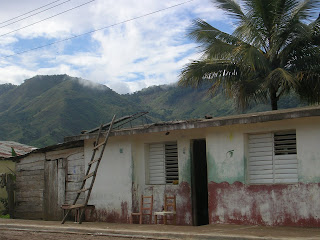My thoughts lately have been drifting away from our pumpkin house farm, and toward the Dominican Republic. Even as I continue in my kefiry, sourdoughy endeavors, and even as the sun breaks through the clouds to welcome a tentative spring, I'm daydreaming of where I hope to be next winter.
This is still related to the theme of finding home, and here's why: I have a second home, one that I haven't visited in several years, but a second home nonetheless.

The last time I visited Rio Limpio was the Christmas before last. I was welcomed back into the family that had first hosted me when I was sixteen and speechless, delivered by an international volunteer program to their doorstep. Reunited, we caught up on what had been going on in each others' lives since my last visit. My host brother had married, had a child, divorced and most recently been almost killed in a truck accident. My host sister, who is studying to be a doctor, was nursing him back to health while continuing to be active in her church. She was also phone-dating an Ecuadorian man who lived in the United States; they were star-crossed lovers, since as an undocumented immigrant he could not leave the US, and my host sister had little desire to go there, and no means of getting a visa anyway. Apart from worrying about her son's injury and her own evolving health problems, my host mother was the only one whose life remained mainly the same. She maintained her complaints about her husband's debt, absence and infidelity, while he maintained his distance and ignored his wife as much as possible.
Funny how when you don't see people for a while, their lives become distilled into a two-dimensional gossip column. But it was so good to see these people, and to have our lives intersect again.
The other news I got caught up on was the news of the town, Rio Limpio. Where there used to be only sporadic electricity, now the government had installed solar panels on all the roofs. Now you could do laundry whenever you wanted . . . while your husband and his friends watched American television. There was also increasing talk of paving the hazardously muddy road into town. There has always been such talk, but with the rate of change in Rio Limpio, now I was starting to believe it.
A paved road would make life better in many ways. It would buy critical hours of travel time, allowing sick and injured people to reach city health care facilities. It would make it easier to visit family in the city, and vice versa. It would indirectly bring all kinds of employment opportunities to a depressed little mountain town.
But people in Rio Limpio complain about the traffic and crime problems in the city, and they lament the loss of time to enjoy life. That's what keeps them in Rio Limpio despite the poverty and struggles of hard manual labor: the chance to sit and talk over coffee with family and friends, to walk across town to call on a sick neighbor or a grieving relative, or to play dominoes in the backyard amidst clucking hens and the blaring of bachata music on a distant radio station.

I'm in no place to judge development in Rio Limpio; I may call it home but I don't live there. I can only look on in wonder as these changes come to pass. Still, I was heartened to find that CREAR, the local school for organic agriculture, had regained its funding and was thriving more than ever. I was also excited to speak with the father-in-law of my host brother, who was working with the eco-tourism office in Rio Limpio, and who was thinking critically about sustainable development and was actively working to guide the town's progress in a way that would be healthy for everyone.
Most of all I was excited to visit a biodynamic farm that I had heard about previously but never actually been to. On the edge of a national park, the farm blended into the forest except that it was brimming with food -- grapefruit, oranges, cacao, coffee, and ginger were all intermixed in what seemed to be a kind of Eden, a magic food forest. At the time, I daydreamed about going back for a longer period of time to do some kind of internship at the farm and nursery, helping with translation if it were needed, and learning about sustainable agriculture in the tropics. Now as I write about it, I'm getting excited about that idea again. I googled it and found that Rio Limpio now has a slick tourism website. It's bizarre to see the people and places I know, who have always seemed a world away, within such an easy reach through cyberspace.
But what does this mean for my oekoseeking here? How can I board a plane and ditch all the things I've been working on? Would they still be here when I got back?
Most of all, do I lose integrity by spreading myself across so much space? Feeling proud as I ride my bike to work, but happily boarding a plane to burn fossil fuels for 3,000+ miles and then talk about "sustainability?"



